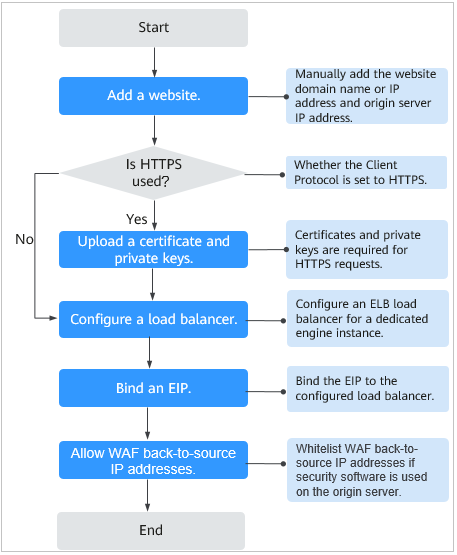Connection Process (Dedicated Mode)
To let a dedicated WAF instance protect your website, the domain name of the website must be connected to the dedicated WAF instance so that the website incoming traffic can go to WAF first.
Constraints
- Dedicated WAF instances can protect only web applications and websites with servers deployed on Huawei Cloud and accessible through domain names or IP addresses. For details about WAF dedicated instances, see Edition Differences.
- A dedicated Elastic Load Balance (ELB) load balancer has been used to distribute workloads for the website you want to add to WAF. For details about load balancer types, see Differences Between Dedicated and Shared Load Balancers.

Dedicated WAF instances issued before April 2023 cannot be used with dedicated network load balancers. If you use a dedicated network load balancer (TCP/UDP), ensure that your dedicated WAF instance has been upgraded to the latest version (issued after April 2023). For details, see Dedicated Engine Version Iteration.
Processes of Connecting a Website to WAF
Before using a dedicated WAF instance, complete the required configurations by following the process shown in Figure 1.
Collecting Domain Name/IP Address Details
Before adding a domain name or IP address to WAF, obtain the information listed in Table 1.
Information |
Parameter |
Description |
Example |
|---|---|---|---|
Parameters |
Protected Object |
|
www.example.com |
Protected Port |
The service port corresponding to the domain name of the website you want to protect.
|
80 |
|
Client Protocol |
Protocol used by a client (for example, a browser) to access the website. WAF supports HTTP and HTTPS. |
HTTP |
|
Server Protocol |
Protocol used by WAF to forward requests from the client (such as a browser). The options are HTTP and HTTPS. |
HTTP |
|
VPC |
Select the VPC that the dedicated WAF instance belongs to. |
vpc-default |
|
Server Address |
Private IP address of the website server. Log in to the ECS or ELB console and view the private IP address of the server in the instance list. NOTE:
The origin server address cannot be the same as that of the protected object. |
192.168.1.1 |
|
(Optional) Certificate |
Certificate Name |
If you set Client Protocol to HTTPS, you are required to configure a certificate on WAF and associate the certificate with the domain name. NOTICE:
|
- |
Fixing Inaccessible Websites
If a domain name fails to be connected to WAF, its access status is Inaccessible. To fix this issue, see Why Is the Access Status of a Domain Name or IP Address Inaccessible?
Feedback
Was this page helpful?
Provide feedbackThank you very much for your feedback. We will continue working to improve the documentation.See the reply and handling status in My Cloud VOC.
For any further questions, feel free to contact us through the chatbot.
Chatbot









